sodium 4-styrene sulfonate

sodium 4-styrene sulfonate structure
|
Common Name | sodium 4-styrene sulfonate | ||
|---|---|---|---|---|
| CAS Number | 25704-18-1 | Molecular Weight | 206.194 | |
| Density | 1.163 g/mL at 25 °C | Boiling Point | 100 °C | |
| Molecular Formula | C8H7NaO3S | Melting Point | 460 °C (dec.) | |
| MSDS | Chinese USA | Flash Point | N/A | |
|
Surface functionality as a means to impact polymer nanoparticle size and structure.
Langmuir 29(12) , 4092-5, (2013) When polymeric nanoparticles (NPs) are formed by nanoprecipitation, which is a nucleation-growth process, the control over size requires changing the polymer concentration or solvent composition. Here, we demonstrate that the NP size can be controlled indepen... |
|
|
A novel pulsed drug-delivery system: polyelectrolyte layer-by-layer coating of chitosan-alginate microgels.
Int. J. Nanomedicine 8 , 877-87, (2013) The aim of this report was to introduce a novel "core-membrane" microgel drug-delivery device for spontaneously pulsed release without any external trigger.The microgel core was prepared with alginate and chitosan. The semipermeable membrane outside the micro... |
|
|
Gastrointestinal adverse events with sodium polystyrene sulfonate (Kayexalate) use: a systematic review.
Am. J. Med. 126(3) , 264.e9-24, (2013) Sodium polystyrene sulfonate (Kayexalate; Sanofi-Aventis, Paris, France) is a cation-exchange resin routinely used in the management of hyperkalemia. However, its use has been associated with colonic necrosis and other fatal gastrointestinal adverse events. A... |
|
|
Divalent-anion salt effects in polyelectrolyte multilayer depositions.
Langmuir 28(45) , 15831-43, (2012) We systematically investigate the effects of divalent anions on the assembly of polyelectrolyte multilayers by fabricating polystyrene sulfonate (PSS)/polyallylamine hydrochloride (PAH) multilayer films from aqueous solutions containing SO(4)(2-), HPO(4)(2-),... |
|
|
Sizing of PDADMAC/PSS complex aggregates by polyelectrolyte and salt concentration and PSS molecular weight.
J. Phys. Chem. B 116(51) , 14961-7, (2012) Herein we report on the influence of salt and polyelectrolyte (PEL) concentration, molecular weight, and mixing ratio on the size and size distribution of polyelectrolyte complex (PEC) particles composed of cationic poly(diallyldimethylammonium chloride) and ... |
|
|
Macromolecular and morphological evolution of poly(styrene sulfonate) complexes with tetradecyltrimethylammonium bromide.
J. Phys. Chem. B 116(40) , 12332-40, (2012) Macromolecular characteristics and morphology of water-soluble complexes between sodium poly(styrene sulfonate) (PSS) and tetradecyltrimethylammonium bromide have been followed as a function of surfactant-to-polymer charge ratio (S/P) to elicit possible chang... |
|
|
Potassium binders in hemodialysis patients: a friend or foe?
Ren. Fail. 35(2) , 185-8, (2013) There is insufficient evidence on the utility of potassium-binding resins in patients with end-stage renal disease on dialysis. In addition, their poor tolerability raises concerns of patient adherence. We aimed to assess the efficacy of calcium resonium and ... |
|
|
Electrosteric stabilization and its role in cooperative magnetophoresis of colloidal magnetic nanoparticles.
Langmuir 28(42) , 14878-91, (2012) A detailed study on the conflicting role that colloid stability plays in magnetophoresis is presented. Magnetic iron oxide particles (MIOPs) that were sterically stabilized via surface modification with poly(sodium 4-styrene sulfonate) of different molecular ... |
|
|
Lithium poisoning: the value of early digestive tract decontamination.
Clin. Toxicol. (Phila.) 51(4) , 243-8, (2013) The objective of this study was to evaluate the effects of early digestive tract decontamination on the severity of acute-on-chronic lithium poisoning (acute poisoning in patients under long-term therapy).This was an observational and retrospective study of a... |
|
|
Fibronectin conformation regulates the proangiogenic capability of tumor-associated adipogenic stromal cells.
Biochim. Biophys. Acta 1830(9) , 4314-20, (2013) Changes in fibronectin (Fn) matrix remodeling contribute to mammary tumor angiogenesis and are related to altered behavior of adipogenic stromal cells; yet, the underlying mechanisms remain unclear due in part to a lack of reductionist model systems that allo... |